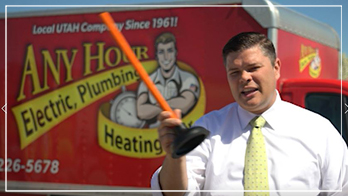
The sink plunger is made primarily for just that: sinks. With its straight handle and flat-bottomed rubber cup, this plunger will only work effectively on a flat surface. The idea is that the cup covers the top of the drain to create a seal. Drains with a curved surface, like that of a toilet, won’t allow the plunger to make a proper seal or create the vacuum necessary to unclog a drain.
Additionally, remember that if you’re working on a double kitchen sink, be sure to cover or otherwise plug up the other drain. The two sinks have a drain that is connected, so you won’t get the pressure necessary to unclog your drain unless you cover one side. Also, if you’re trying to unclog a drain in a bathroom sink, be sure to cover or plug up the drain hole there as well.
Check out our video on: How to Unclog a Kitchen Sink with a Plunger
→ The Rundown: This plunger works best on most sinks, tubs, or drains on a flat surface.

It’s called a toilet plunger, but don’t let that get you down. This plunger’s versatile construction makes it a good fit for nearly any drain! Its tubular shape at the bottom makes it a good fit for curved toilet drains and the cup shape at the top allows for suction over flat-surfaced drains like tubs and sinks. This is possible because the inner tube can be tucked up into the cup so you can just use the suction cup part. However, just because your plunger CAN work on any drain, that doesn’t mean it SHOULD. Never use the same plunger on a tub or sink that you’ve used on a toilet as this could spread germs and disease. So, it’s best to designate a dedicated toilet plunger and a dedicated sink/tub plunger. If the two are the same style, make sure they are clearly marked so they don’t get mixed up.
The Rundown: This is the best plunger for toilets and is also versatile enough to fit most sink and tub drains. But buy more than one if you’re going to use it for both your sinks and toilets!

Made up of rigid plastic, the accordion plunger can pack a punch to stubborn toilet clogs. However, while it can produce a lot of force, it is not very easy to use. Because the plastic is stiff, creating a vacuum seal over the drain can be challenging. Also, because this plunger is made of plastic and not traditional rubber like other plungers, it’s possible this plunger might scratch the surfaces of your toilets.
The Rundown: This plunger is pretty much only good for toilets.
